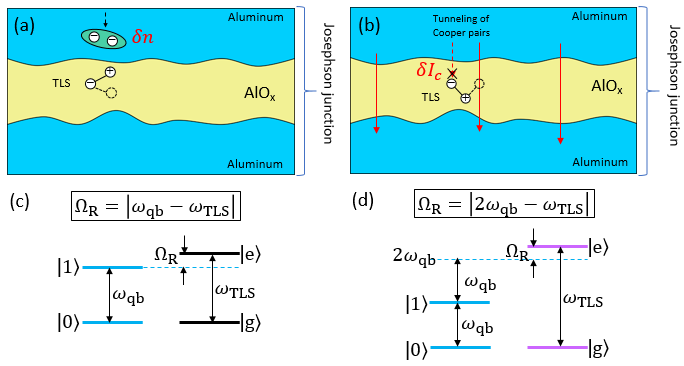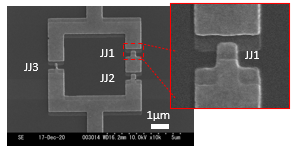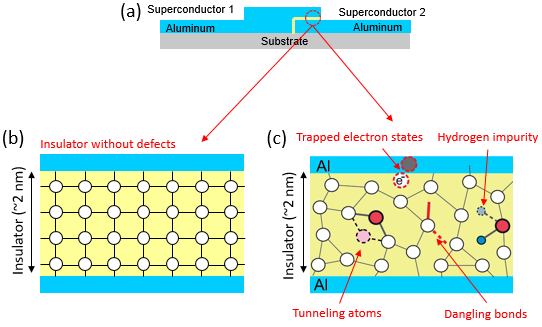Microsoft ends support for Internet Explorer on June 16, 2022.
We recommend using one of the browsers listed below.
- Microsoft Edge(Latest version)
- Mozilla Firefox(Latest version)
- Google Chrome(Latest version)
- Apple Safari(Latest version)
Please contact your browser provider for download and installation instructions.
December 22, 2022
Nippon Telegraph and Telephone Corporation
Japan Science and Technology Agency (JST)
Realization of a novel method for the detection of parasitic defects in superconducting qubits
~Paving the way for removing defects in quantum processors~
Nippon Telegraph and Telephone Corporation (NTT, Head office: Chiyoda-ku Tokyo; President & CEO: Akira Shimada) and the National Institute of Advanced Industrial Science and Technology (AIST) have realized a novel technique for the detection of parasitic defects in superconducting qubits. Superconducting qubits*1 are among the most promising hardware platforms for building a quantum computer, but the realization of a full-scale fault-tolerant quantum computer remains a challenging task due to limited lifetimes of the superconducting qubits. One of the major noise mechanisms limiting the qubit lifetimes is due to unwanted two-level-system (TLS) defects*3 in superconducting qubits. Therefore, investigation and mitigation of noise contributions from TLS defects are crucial for the further improvement of superconducting quantum processors.
In this work, NTT and AIST introduce a novel method of defect spectroscopy in superconducting qubits that allows one to distinguish different types of TLS defects. The reported method will become a valuable diagnostic tool for quantifying TLS defects and finding optimal techniques and materials for the fabrication of defect-free superconducting qubits.
This research was reported in the American journal PRX Quantum on December 21, 2022. This work was partially supported by JST CREST (JPMJCR1774) and JST Moonshot R&D (JPMJMS2067).
1. Background
The performance of conventional computers is expected to reach its physical limits in the near future, and scientists around the world actively explore new ways of computing. Quantum computation is an emerging computing paradigm which is based on well-studied, but not yet fully exploited quantum phenomena such as quantum superposition and entanglement. The key building block of a quantum computer is a qubit – a computing element that can store quantum information – and the mainstream technology of quantum computing is based on superconducting qubits where quantum information is encoded in quantum states of superconducting electric circuits.
Despite the impressive progress in building modest-scale superconducting qubit systems in recent years, realization of a universal quantum computer is still a very challenging task. The major obstacle is the rapid loss of quantum information due to the interaction between a qubit and a noisy environment.
One of the main noise sources in superconducting qubits are atomic-scale parasitic defects which are located inside oxide layers formed on the top of superconducting materials. In our work we introduce a novel microwave technique that allows one to identify the type of a parasitic defect. The presented approach complements methods for the characterization of other types of noises in superconducting qubits, enabling further improvement in the performance of superconducting quantum processors.
2.Achievements
The research group proposed and demonstrated a method for identifying different types of two-level-system defects in superconducting qubits. Although the existence of different types of TLS defects was predicted previously by several theoretical works, this is the first time the experimental demonstration of two different types of TLS defects has been reported.
2.1 Detection condition of two level system defects
There are two main types of the interaction between superconducting qubits and TLS defects. First, the charge fluctuation of the two-level system can cause the displacement of the charge in the Josephson junction, resulting in the Coulomb interaction between the TLS defect and the qubit charge degree of freedom (Fig. 1a). Second, the charge fluctuation of the two-level system defect can cause a change in the supercurrent through the Josephson junction, thereby coupling the TLS defect to the superconducting phase fluctuations of the qubit (Fig. 1b).
Charge-type-interaction TLS defects are detected when there is a resonant transfer of one excitation of a qubit into one excitation of a TLS defect (Fig. 1c). Here, the difference in frequency between the two, | ωqb-ωTLS | is compensated by the additional frequency shift ΩR caused by the microwave driving of the qubit. On the other hand, a two-level system defect with the critical-current-type interaction is detected when there is a transfer of two qubit excitations into one excitation of a two-level system defect. In experiments, qubit excited states are populated by a strong resonant microwave drive. By finding a way to determine the number of qubit excitations involved in the qubit-defect resonance transfer, the authors were able to identify different types of TLS defects.
 Fig. 1 (a) Two-level-system defects with the charge-type interaction. (b) Two-level-system defects with the critical-current-type interactions. (c) Detection conditions for TLS defects with the charge-type interaction. (d) Detection conditions for TLS defects with the critical-current-type interaction. Here, ΩR, ωqb, ωTLS represent microwave intensity, quantum bit transition frequency, and TLS defect transition frequency, respectively.
Fig. 1 (a) Two-level-system defects with the charge-type interaction. (b) Two-level-system defects with the critical-current-type interactions. (c) Detection conditions for TLS defects with the charge-type interaction. (d) Detection conditions for TLS defects with the critical-current-type interaction. Here, ΩR, ωqb, ωTLS represent microwave intensity, quantum bit transition frequency, and TLS defect transition frequency, respectively.
2.2 Spectrum of two-level system defects
The difference in the described detection conditions can be visualized by measuring the spectra of two-level system defects. Here, we measured the spectra of two level system defects while sweeping the magnetic flux applied to the flux qubit (Fig. 2b, c). The spectral lines of two-level system defects TLS1-TLS3 shown in Figure 2 c demonstrates the same curvature as the spectrum of the qubit in Figure 2 a, indicating that it is a charge-type-interaction TLS defect in which one qubit excitation is transferred into one excitation of the two-level system. On the other hand, the spectral lines TLS4, TLS5 of two-level system defects shown in Fig. 2c demonstrate twice the curvature of the qubit spectrum, indicating a critical-current-type interaction in which two qubit excitations are transferred into one excitation of the two-level system defect.
 Fig. 2 (a) Microwave absorption spectra of flux qubits. (b) Spectra of two-level defects (experiment). (c) Spectra of two-level defects (experiment + fitting).
Fig. 2 (a) Microwave absorption spectra of flux qubits. (b) Spectra of two-level defects (experiment). (c) Spectra of two-level defects (experiment + fitting).
3.Technical features
(1) By analyzing the coupling model of superconducting qubits and two-level system defects in detail, the authors found that the detection conditions were different depending on the type of the coupling between a qubit and a TLS defect.
(2) By measuring the spectra of two-level system defects while controlling the transition frequency of superconducting qubits, the authors succeeded in visualizing the difference in the coupling type between qubits and two-level system defects.
4.Future plans
The reported method can be applied to identify different types of two-level system defects, which is expected to help elucidate the physics of defects in superconducting qubits. In addition, the method can be used to provide feedback for the sample fabrication process to optimize the fabrication process and materials, enabling the realization of defect-free and long-lived superconducting qubits.
In a short term, the reported method can be used to extract parameters necessary to model noise due to two-level system defects, which can be applied to qubit gate operation optimization necessary to further improve the performance of small-scale quantum computer prototypes that are currently available.
Publication information
Journal: PRX Quantum
Title: Identification of different types of high-frequency defects in superconducting qubits
Authors: Leonid V. Abdurakhimov, Imran Mahboob, Hiraku Toida, Kosuke Kakuyanagi, Yuichiro Matsuzaki, and Shiro Saito
<Glossary>
*1Superconducting flux qubits
A superconducting circuit composed of a superconducting loop containing multiple Josephson junctions*2, in which two states, a right-handed current state and a left-handed current state, can be treated as a quantum two-level system by applying an appropriate magnetic field bias (see Figure 3).
 Fig. 3 Superconducting flux qubit. Here JJ stands for Josephson junction.
Fig. 3 Superconducting flux qubit. Here JJ stands for Josephson junction.
*2Josephson junctions
A nonlinear superconducting circuit element that consists of an extremely thin insulating film sandwiched between two superconductors (Fig. 4a). The supercurrent through a Josephson junction is a nonlinear function of the superocnducting phase difference across the junction. In superconducting qubits, aluminum is often used for superconductors and aluminum oxide for insulating films.
 Fig. 4 (a) The cross-sectional view of a Josephson junction. (b) The ideal structure of a Josephson junction. (c) The realistic structure of a Josephson junction. Here TLS defects are formed inside an amorphous aluminum oxide layer.
Fig. 4 (a) The cross-sectional view of a Josephson junction. (b) The ideal structure of a Josephson junction. (c) The realistic structure of a Josephson junction. Here TLS defects are formed inside an amorphous aluminum oxide layer.
*3Two-level-system (TLS) defects
Various atomic-scale defects that exist in amorphous oxide layers formed in the insulating layer of a Josephson junction and on the surface of an aluminum film, as shown in Fig. 4c. A TLS defect can be modelled as a localized charge, which can travel between two stable spatial states, and treated as a quantum two level system.
Contact Information
Nippon Telegraph and Telephone Corporation
Science and Core Technology Laboratory Group, Public Relations
nttrd-pr@ml.ntt.com
TEL: 046-240-5157
About Program
Yuko Shimabayashi
Department of Strategic Basic Research,
Japan Science and Technology Agency
crest@jst.go.jp
TEL:+81-3-3512-3531
Koh Inukai
Department of Moonshot Research and Development Program,
Japan Science and Technology Agency
moonshot-info@jst.go.jp
Tel:+81-3-5214-8419
Information is current as of the date of issue of the individual press release.
Please be advised that information may be outdated after that point.
NTT STORY
WEB media that thinks about the future with NTT









